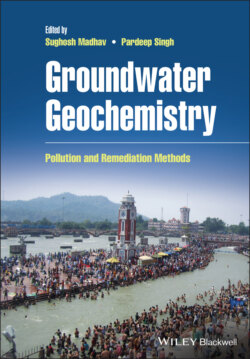Читать книгу Groundwater Geochemistry - Группа авторов - Страница 14
1.2 Arsenic
ОглавлениеArsenic is overarching with a variable amount in the Earth's crust, mostly in the form of arsenate and arsenite (WHO 2011). In water, generally, it is present as arsenate (As V) in oxidizing condition and as arsenite (As III) form in reducing condition. The fresh biomass, rainfall infringement in the recent alluvium may be the reason for the evacuation of As and Fe from the sediments or soils (Aulakh et al. 2009; Raju et al. 2012). It is introduced in water via different sources such as the dissolution of minerals, rocks, and soil, mining activity (mining waste), mineral smelting, coal combustion, industrial effluents, and through the dry and wet deposition of atmosphere's dust. It is used commercially as the alloy in the formation of semiconductors and in other electricals. Moreover, it used as a preservative for wood, and industrially in the textile, paper, and glass industries for processing. It is also used in pharmaceuticals, food additives, and pesticides to a small extent. The average concentration ranged from 1–2 mg/kg in the continental crust, in which 1.5–3.0 mg/kg was in igneous rock followed by 1.7–400 mg/kg in sedimentary (CGWB 2014).
Arsenic contamination is distinguished in important basin river basins of India, the Ganga and Brahmaputra river basins. These two rivers originated from the Himalayas and create the two significant river basins of India. The As contaminants are prevalent in the lowland area rich with either organic or clayey deltaic sediments in the Bengal basin, as well as sites of the entrenched river channels having the similar facies but sometimes in small pockets in the middle Ganga plain (MGP), i.e. Uttar Pradesh, Bihar, Jharkhand, and West Bengal (Chakraborti et al. 2002; Raju et al. 2012; Saha and Sahu 2016; Tirkey et al. 2017; Kumar et al. 2019). Arsenic induced groundwater deterioration in MGP to the lower Ganga Plain including Uttar Pradesh, Bihar, Jharkhand, and West Bengal and consistently created an adverse impact on human health.
Arsenic is more concentrated in the alluvial aquifers, small lenses in the MGP, low‐lying basin of Bengal, and localized contamination through the gneissic aquifers in Chhattisgarh. Geographically, the large area comes under arsenic contamination from the 89 blocks and 57 blocks in West Bengal and Bihar, respectively. Arsenic contamination is also pervasive sequentially in Uttar Pradesh, Jharkhand, Haryana, Punjab, Manipur, and Assam (Aulakh et al. 2009; Saha and Sahu 2016; Lapworth et al. 2017; Tirkey et al. 2017; Kumar et al. 2019). Most of the cases were reported from the younger alluvial aquifer systems (CGWB 2014).
